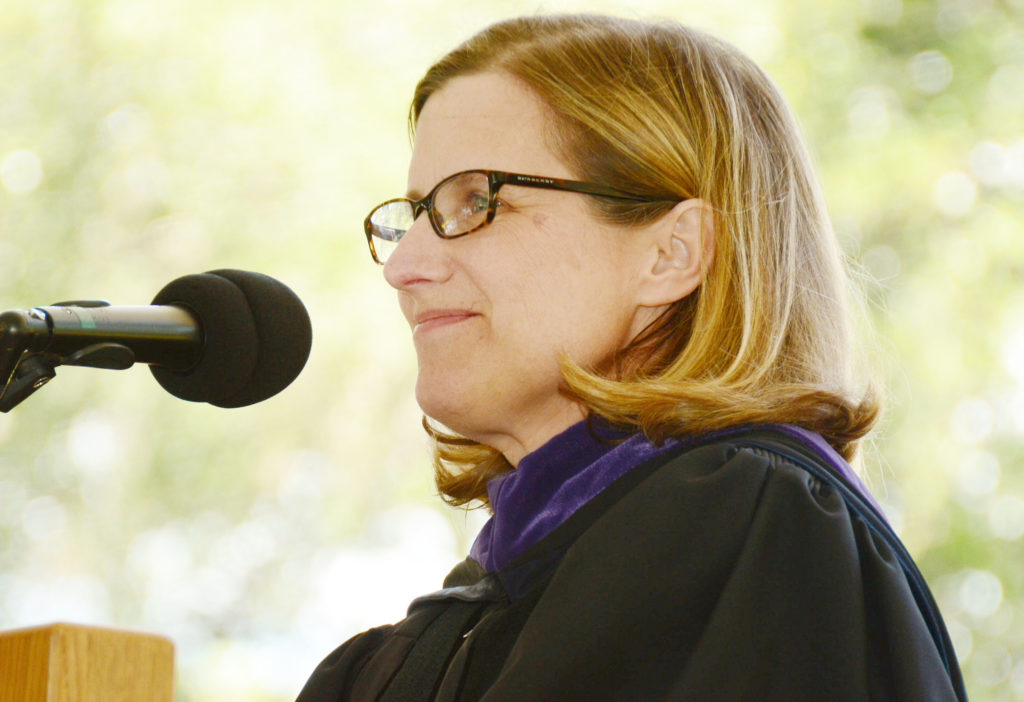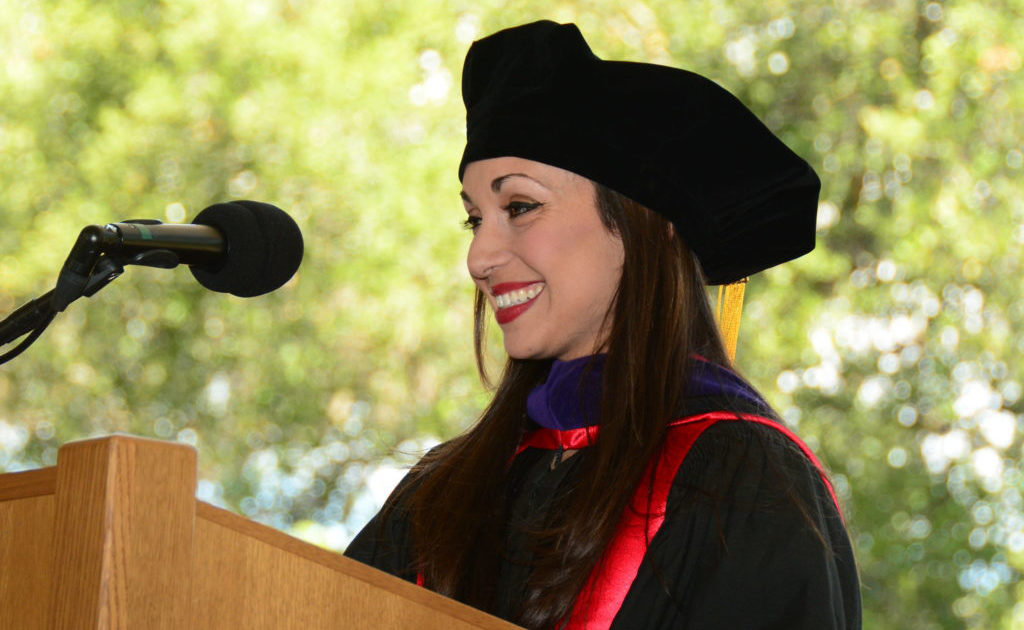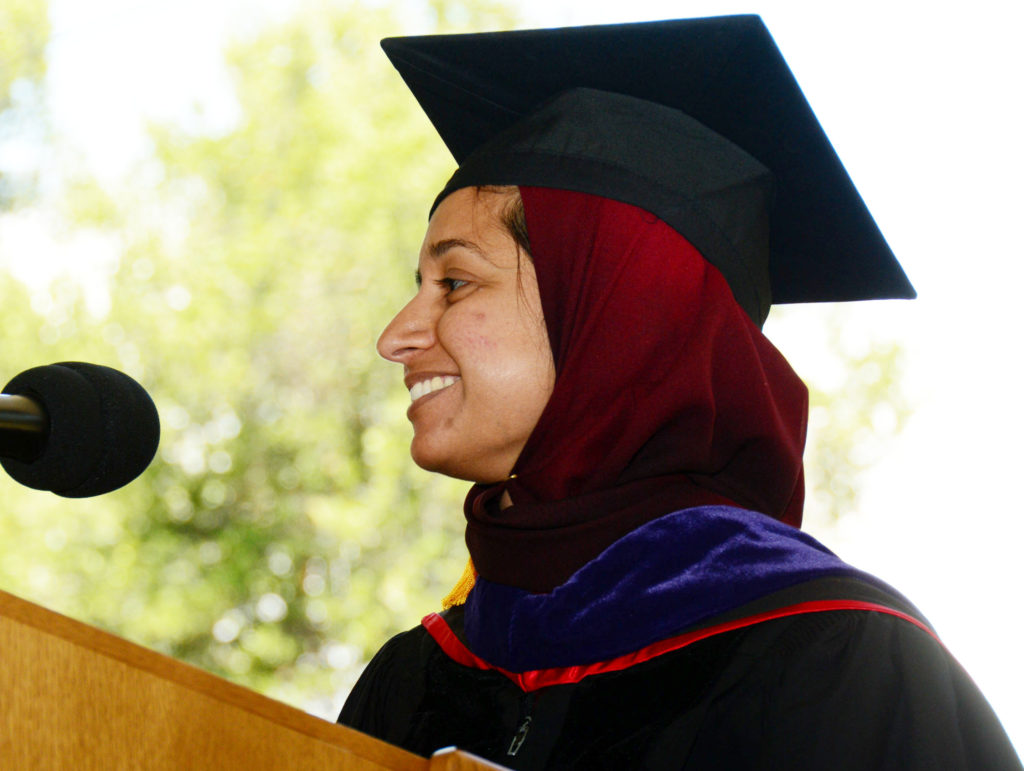Stanford Law Graduates Charged with Creating Strong Communities Wherever They Land

The importance of community was center stage at Stanford Law School’s Class of 2016 graduation ceremony on Saturday, June 11.
M. Elizabeth Magill, Richard E. Lang Professor of Law and Dean, welcomed the 1,500 or so family and friends of the 252 JD and advanced degree recipients and invited the students to thank those who brought them there and also take great pride in what they had achieved.
Culmination of Hard Work
Kimiya Shams Shash Javani, LLM ’16, the first of two student speakers elected to represent the advanced degree graduates, gave the first address to the class.
Noting that the advanced degree students are “diversity per definition,” representing 31 countries and speaking 22 languages, Javani focused on a phrase many Stanford students hear repeatedly: “You are so lucky.” Yet, Javani said “it was never pure luck that brought us here, but our commitment to hard work and our mission to be our best selves,” and “these two factors are key components that we will carry with us while serving clients worldwide.”

Serve Others by Recognizing Humanity
Speaking next was Courtney Khademi, selected by the JD class to speak. Khademi told the story of Carrie Buck, the plaintiff in the U. S. Supreme Court case Buck v. Bell, who was forced to undergo compulsory sterilization while confined to the Virginia State Colony for Epileptics and Feebleminded.
Khademi chose Buck’s story to remind the audience that, like Buck, “The individuals who become the legal system’s participants—occasionally deliberately, more often due to circumstances outside of their control—become something less than flesh and blood human beings and something closer to mere identifiers” when law students are learning cases. “But,” she said, “I would argue that [the heart of our role] is doing our best to recognize and honor the human beings whose daily lives generated the opinions we read.”
For Khademi, one of the best things about the Class of 2016 is the way her classmates went out of their way to get to know clients as people.
“One of our classmates this year represented a man who spent six years in jail simply awaiting trial, and she came to know this person,” she said. “Here are some things she learned about that man: His name is Charles. He used to work as a power washer. He loves work. He has five kids. He is spiritual and soft-spoken.” That SLS student was “at least one person who chose to know who he is.”
In practice, Khademi said, graduates can “use our power to demonstrate to others that we will ask who they are, and what they love, and who they love, and we will remember their details, and we will make at least one of their memories our own, and we will hold it and carry it forward … Because that is the heart of our job: assuring others that the world sees them, assuring others that the world knows them.”
Presentation of Awards
Haley Anna Horton and Dana Rehnquist, 2016 JD class co-presidents, then presented the awards for 2016. Marcus Sean Bourassa, JD ’16, received the Dean’s Award for Excellence in Service to Stanford Law School, and Shila Cedron of the Law Café received the Staff Appreciation Award.
Horton and Rehnquist next presented the John Bingham Hurlbut Award for Excellence in Teaching to Shirin Sinnar, JD ’03, assistant professor of law and John A. Wilson distinguished faculty scholar.
In her speech, Sinnar reflected on her experience with the class.

Align Vision and Values
“This past year, as presidential candidates stoked fear and xenophobia the likes of which we have not seen in generations, we asked together whether law could resist the escalating drumbeat of exclusionary calls when so often in our history, it has failed to do so,” Sinnar said. “Together, over the past three years, we questioned the chasm between law and justice and explored the means to narrow that gap. It’s been a remarkable three years.”
But, she said, the most important message for the class was more personal than political. Sinnar encouraged graduates to align their values to their lives, noting, “Too often, we are taught to climb some mythical single ladder of academic and professional success. Too often, we absorb the message that we should judge ourselves against the accomplishments of others. If life or law school has taught you such lessons, unlearn them now. Make the space to know yourself and to align your life to your core vision and values.”
Sinnar also urged graduates to treat themselves, and others, with care and respect in order to be able to extend compassion to clients and others.
“No vision is worth pursuing that sacrifices your well-being to your work, no matter how noble the cause,” she advised. “If you believe in honoring the dignity of each individual, you must begin by honoring yourself. You each deserve the care and compassion you so readily extend to others.”
Obligation to Create Strong Communities
Dean Magill closed the ceremony with the traditional dean’s “Charge” to the class, focusing on the importance of creating and sustaining strong communities. “My question is this,” she said. “What makes a community where all its members thrive?” Noting that the answers lay with the class of 2016’s experiences at Stanford, Magill recalled students who went beyond their job description to create community, an open community where students felt free to engage in critical self-reflection and prompt change, and a commitment to service to others in need.
She went on to share what she had heard from students over the past few weeks when she asked them to describe their experience of Stanford Law School: tight-knit community, kind, decent, familial, generous, warm, freeing. Not the usual words to describe law school, according to Magill.
“It is not an easy ride, and all of you know it,” she said. How is it possible, she asked, to combine the words some students used to describe the law school experience like “pushed to the point of breaking” with words like “supportive and cooperative” or “optimistic, empowering and inspiring”? “If we can figure that out, we will know a lot about how to create and sustain a community where all can thrive,” she added.
Many students went the extra mile to organize events like the fall 1L celebration, going to see a friend argue an appeal, making a video to thank their clinical professor, hosting nationally themed dinners and parties, and participating in the Rite of Spring last May, the talent show, a scavenger hunt, the many reading groups, and more.
But a community where all can thrive must also feel open to all, she said. “That means several things. It means welcoming difference, and a capacity for critical self-reflection and change.” She added, “Your time in law school has been a hard time to study law. You all came to law school with optimism about the promise of law and the legal system. But for some of you, that faith has been shaken in these last few years—especially by the role that racial prejudice and collective indifference play in the lives of so many people of color and in the criminal justice system. And what have you done? You have stepped up. You learned and dug deep” into these issues.
Another feature that builds strong community, Magill said, is having many members of the community engaging in service to others who need it most. Describing student work in public service and beyond, Magill told the class that a good community depends on having many members of the community committed to the service of others and the celebration of that service by all.
Magill urged the class to carry this commitment to community forward: “My charge to you is to take lessons from this place, and translate them wherever you land.”
She said, “In some places, you will find thriving schools, communities and workplaces and you will need to help sustain them. In other places, you will find something much more challenging: broken communities. It is a big lift to make changes to such a community because so little of what I’ve talked about is embodied in rules or the structure that could be changed. Instead, it’s rooted in norms, attitudes and the way people interact with each other one-on-one, even when they are challenged or under stress. So much of it is about modeling action that others will learn from.” She ended by conveying the confidence of the faculty in the graduates’ ability to take on this challenge.
